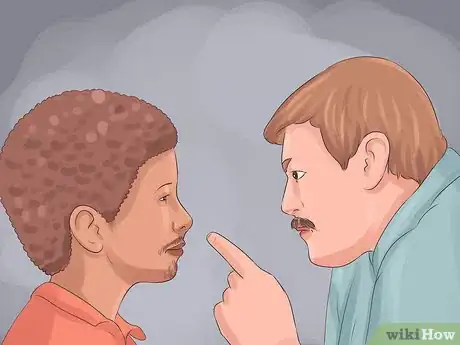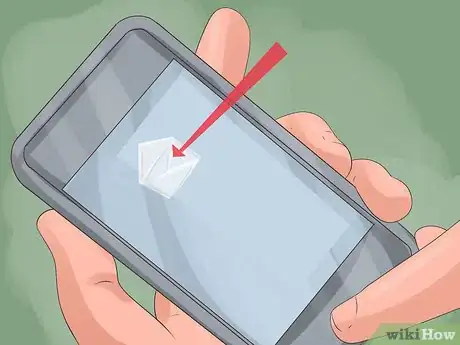This article was co-authored by John Keegan. John Keegan is a dating coach and motivational speaker based in New York City. He runs The Awakened Lifestyle, where he uses his expertise in dating, attraction, and social dynamics to help people find love. He teaches and holds dating workshops internationally, from Los Angeles to London and from Rio de Janeiro to Prague. His work has been featured in the New York Times, Humans of New York, and Men's Health.
This article has been viewed 585,932 times.
Reading people's body language is complicated because communication is not universal. You have to look at the signs in the context of the other person's personality, social factors, what he says and how he says it, and the setting. You might not have access to all of this information, but it helps to use as much of it as you can. By knowing the context, you can interpret someone's body language and try to see if their body is saying something that their words are not.
Steps
Watching for Lies
-
1Reject myths about body language. There is no one universal sign for lying, otherwise no one would be able to lie successfully! Someone's body language is the result of their current situation, energy level, personality, confidence, and intimacy with you.[1]
- There are many behaviors that are commonly associated with lying, which then people avoid doing while they are lying to avoid getting caught. For example, it is often believed that looking down is a sign of lying, and so many liars avoid looking down when lying.
- Some people develop particular ticks, habits, or responses for certain emotions or situations they're in. If you know these, you might be able to catch a lie. For example, if you know your son usually smiles when he lies, you can use that body language as an indicator.
- If you know someone's ticks and habits, it is likely that the person knows them too. Most people compensate to avoid body language that might be a cue that someone is lying. For example, if you and your son both know that he usually smiles when lying, your son might avoid smiling during a lie to mislead you.
-
2Know the few patterns that exist. Though there are no universal signs of lies, there are general trends of body language that indicate lying. People who are lying are generally more tense: their pupils dilate, and they are more likely to fidget with their bodies. People who are lying also generally try to look like they're indifferent.
- However, someone may have be fidgeting or look indifferent, and not be lying
- The patterns of body language vary wildly from person to person
- Pupil dilation can happen for a number of reasons other than lying
Advertisement -
3Accept your own strengths and weaknesses. Body language is a “nonverbal channel,” or a way through which you can receive messages from other people that does not involve words or speaking. There are three main channels: kinesics (facial expressions, eye contact, and body language), haptics (touch), and proxemics (personal space).
- Generally speaking, you are going to be the most skilled at understanding kinesics, and then proxemics, and then touch.[2]
- People are usually better at understanding pleasant kinesics rather than than unpleasant. So, that means you will be better at spotting happiness and excitement, in contrast to fear, disgust, or lying[3]
- If you do not understand what proxemics means exactly, do this test. The next time you are in a line for something with strangers, stand in line as you usually would. Now take a whole step closer to the person in front of you. Does the shorter distance feel more uncomfortable? Does the other person adjust according to your own movement? The nonverbal communication about personal space is proxemics.
-
4Learn cultural differences. Nonverbal messages differ by culture. For example, in Finnish culture, when someone makes eye contact, she is sending a signal of friendliness.[4] Alternatively, in Japanese culture, when someone makes eye contact, the are interpreted to be expressing anger.[5] Remember the cultural context of you, your guy or girl, and the situation you're in.
Listening for Lies
-
1Listen for less. When people lie, they are likely to use short responses to questions and elaborate less about their story. They might also pause and take longer to respond. When they do respond to statements and questions from others, people will give fewer rich details.
- Try prompting the other person to tell a story that should be long. For example, ask what that person's plans are for the holidays. Avoid asking questions whose answers could be “yes” or “no.”
-
2Pick up on the details. If you listen carefully to the way the person tells his or her story, you can sometimes tell if it's a lie. Liars use more sense-based words, like “I saw,” “it smelled like,” or “I heard.” They also will probably use other-oriented pronouns and phrases, like “she forgot this” or “something happened to the car” instead of “I forgot this.”
- Liars are less likely than truth-tellers to correct themselves while telling a story.
- Look out for more far-fetched stories, that seem outside of the realm of possibility.
- People who are lying generally use fewer gestures.
-
3Notice her/his voice. Is the person speaking in a higher tone than normal? Is the person speaking faster than normal? Quieter or louder? The discomfort of lying usually makes people's voices sound higher, but some individuals may compensate or go another route. If your significant other is speaking in unusual tones, it might be a sign.
Investigating Behavior Changes
-
1Notice when they're there. There may be long periods of time where you don't know where your partner is. Unexplained chunks of time may be a sign of lying, or your partner is lying about where they are.
- Talk to your partner about what they do when you're not there. Be respectful of the other person's space, as well as the relationship you have.
- You can double-check stories by asking friends, family, or coworkers.j
-
2Check your finances. Dishonesty in relationships can stem from financial disagreements or troubles, and it is important that you check your bank account, extra cash, and wallet. This step is more pertinent for married couples, but applies to anyone with shared finances.
- Look for any charges that are unfamiliar to you.
- Don't root through someone else's personal financial history without their permission. You can look through your own.
-
3Observe what they do. When your guy or girl is around, they might act differently than they used to. This could be anything from checking their phone more often to kissing you before bedtime. Behavior changes can signify almost anything, including lying. Investigate the cause of a behavior change in case it is that your guy or girl is lying.
- One common change is the response to questioning: often, people who are lying do not like being questioned. “Why don't you trust me?” or “Who wants to know?”
- The behavior change might be most obvious in social media, texting, or at work. It might not be the most obvious to you.
-
4Examine your own relationship. Has trusting your guy or girl been an ongoing problem? Have you caught your partner in a lie before? At some point, the problem is not whether your partner is lying to you: the problem is that you feel like your partner could be lying to you at all. If you suspect your partner is lying to you, look at the overall picture of your relationship with this person. Systemic or serial lying can be a sign that something in the relationship is not working.[6]
- If your partner is lying, you must decide if you want to move forward in the relationship and forgive.
- For forgiveness to occur, the wrongdoer must accept responsibility, show remorse, and repair the relationship by changing their behavior. You must acknowledge their efforts and reinforce a positive perspective.
Expert Q&A
-
QuestionMy partner got really defensive when I questioned them about something—does that mean they're lying?
 John KeeganJohn Keegan is a dating coach and motivational speaker based in New York City. He runs The Awakened Lifestyle, where he uses his expertise in dating, attraction, and social dynamics to help people find love. He teaches and holds dating workshops internationally, from Los Angeles to London and from Rio de Janeiro to Prague. His work has been featured in the New York Times, Humans of New York, and Men's Health.
John KeeganJohn Keegan is a dating coach and motivational speaker based in New York City. He runs The Awakened Lifestyle, where he uses his expertise in dating, attraction, and social dynamics to help people find love. He teaches and holds dating workshops internationally, from Los Angeles to London and from Rio de Janeiro to Prague. His work has been featured in the New York Times, Humans of New York, and Men's Health.
Dating Coach Sometimes people will get extremely aggressive in their denial, and they might even blame the other person and try to turn the tables around on them. However, everyone deals with things differently, and it doesn't necessarily mean they're lying.
Sometimes people will get extremely aggressive in their denial, and they might even blame the other person and try to turn the tables around on them. However, everyone deals with things differently, and it doesn't necessarily mean they're lying.
References
- ↑ Knapp, M., Hall, J., & Horgan, T. (2013). Nonverbal communication in human interaction. Cengage Learning.
- ↑ Greene, J. O., & Burleson, B. R. (Eds.). (2003). Handbook of communication and social interaction skills. Psychology Press.
- ↑ Wagner, H. L., MacDonald, C. J., & Manstead, A. S. (1986). Communication of individual emotions by spontaneous facial expressions. Journal of Personality and Social Psychology, 50(4), 737.
- ↑ Akechi H, Senju A, Uibo H, Kikuchi Y, Hasegawa T, et al. (2013). Attention to Eye Contact in the West and East: Autonomic Responses and Evaluative Ratings. PLoS ONE 8(3): e59312.
- ↑ Akechi H, Senju A, Uibo H, Kikuchi Y, Hasegawa T, et al. (2013). Attention to Eye Contact in the West and East: Autonomic Responses and Evaluative Ratings. PLoS ONE 8(3): e59312.
- ↑ John Keegan. Dating Coach. Expert Interview. 8 April 2021.








































































